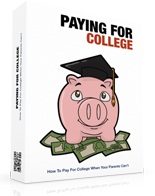
 License Type: Personal Use
License Type: Personal Use  File Type: ZIP
File Type: ZIP
 SKU: 62254
SKU: 62254  Shipping: Online Download
Shipping: Online Download
Sample Content Preview
Introduction
It’s no surprise that the cost of a college education has gone up. What might be surprising is by how much. Without adjusting for inflation, the cost of a college education has tripled in the past 20 years. The cost for a four-year private school can reach over $50,000– 100,000. The cost of a four-year state college can run as high as $35,000 – and that’s for in-state tuition.
Possibly the most talked about way to afford a college education is through student loans. But is this always the best solution? Student loans have become the subject of complaints and regrets, as the borrower is often stuck paying on that loan for many years to come. There has to be a better way.
The good news is that yes, there are alternatives to this course of action. Or at least there are things you can do to avoid borrowing so much that you become buried in crushing debt. There are other places to look, other options to explore and there are even different types of loans available that might work out better for you in the long run. Some of this will take research, legwork, and even a little trial and error. But being able to pay for your college without having to be stuck with huge debt at the end is a huge relief and will enable you to relax and enjoy your college years.
Overview of Resources
Don’t assume that you’re just going to have to go into debt and there is nothing to be done about it. On the contrary, that’s not true at all. Even if you do get a loan, not all loans are created equal. Private loans especially.
But before beginning the loan process, let’s take a look at some other “free” resources. Only after you’ve explored the options, should you go to the loans, as these should be a last chance option after you’ve exhausted all other leads.
Just remember that whatever path you choose, the earlier you start this process, the better. But even if you’re already in college, think about applying for these services for next year, or the year after that. No one should ever have to pay full price for college unless they truly have no other choice.
In this section, let’s take a look at some of the available options. This is by no means an exhaustive list, but it should be able to get you started.
FASFA
The FASFA or Free Application for Federal Student Aid application is available at StudentAid.edu.gov. This should be the very first thing you should do when looking for money for college. The good news is the application process is reasonably painless. So, do this even if you don't think you'll qualify. There are millions of students who could have qualified for the FASFA assistance but never applied because they didn’t think it was for ‘people like them.’
But FASFA isn’t just about Federal Grants. Believe it or not, this same application will help you to qualify for Loans or even Work-Study Funds. It comes from the US Department of Education and is backed by over $1.5 billion in student aid every year. That’s a lot of money just waiting for you to find it.
And there’s even an online tool to assist you filling this form out and to estimate the amount of aid available.
Keep in mind, that the US Department of Education (USDOE) will not charge for any assistance in filling out the form or in estimating how much aid you might be eligible for. Be leery of sites that do.
Fill out the application early. FASFA doesn’t just access the USDOE funds but can make you available for many state and even College-level assistance programs. But these are often available on a first-come-firstserve basis.
Scholarships
The sooner you start looking for these, the better. There are many divergent types of scholarships, thousands of them. They’re not always for the academic whiz kid or super athlete either.
Among the stranger scholarships? There is a $2,000 scholarship grant for the best duck call. There are scholarship awards for designing prom dresses with Duct tape. Another gives out $1,000 to men just for being over 6’2” and women for being over 5’10.”
With so many scholarships available it’s easy to get overwhelmed. In the next chapter I’ll outline some places where you can do your research, find where they are and apply early while funding is still available.
Start with an Affordable School
Consider a junior college or a community college, at least as a starting off point for your education. The advantage here is that you can get the core classes out of the way that would be the same regardless of your major. Most of these credits are pretty easy to transfer to a four-year college down the road. Be sure to ask though, because not ever credit automatically will go where you want to. Do your homework before you begin.
Technical colleges are also an affordable alternative, especially if you have a goal that involves special skills such as welding or cosmetology. Even when getting a four-year university option, look for the school with the best aid, not the lowest price. It’s possible that the highest-priced school may end up costing you less out of pocket if they have better aid options for their students.
All of this takes research. Find the places you’d like to go, then inquire about their financial aid packages and what they can offer you to help defray the cost of your education.
Grants
The best thing about grants is that they don’t have to be paid back. Again, start by filling out the FASFA paperwork. It is estimated that there are billions of dollars in unclaimed federal Pell grant money because the people who are qualified for them simply do not apply.
There are other opportunities available besides the Pell, both local and national grants. The Department of Education website has a map that will list grants being offered in your area.
Work-study programs
Getting a college job helps out in many ways: it provides income, usually close to the campus (if not on it) with hours flexible enough to work around your class schedule. These programs also include internships that allow you to network, making connections that might prove valuable to you upon graduation. The FASFA application will let you know if you qualify for work study. If you do, then it’s a simple matter of finding out what work-study programs are already available on campus.
Savings
As a national average, a student’s family covers 34% of college tuition. That means touching savings accounts and income to pay for such things as living expenses and tuition and books. But these also require directing some of the family income to these expenses and work best when there’s been a plan in place to save for college long before you need to go.
Federal Loans
The sort of thing you’ve been avoiding, but to fill in the gaps, a federal loan may be necessary. But use it for that - the gaps. There’s a big difference between a loan of $5,000 and one of $50,000 A rule of thumb is not to borrow more than you plan to make in the workforce after graduation. If you think you’re going to make $45,000 your first year out of college, don’t borrow more than that for your education.
- License: Personal Use
- Category:Ebooks
- Tags:2018 Ebooks Personal Use







